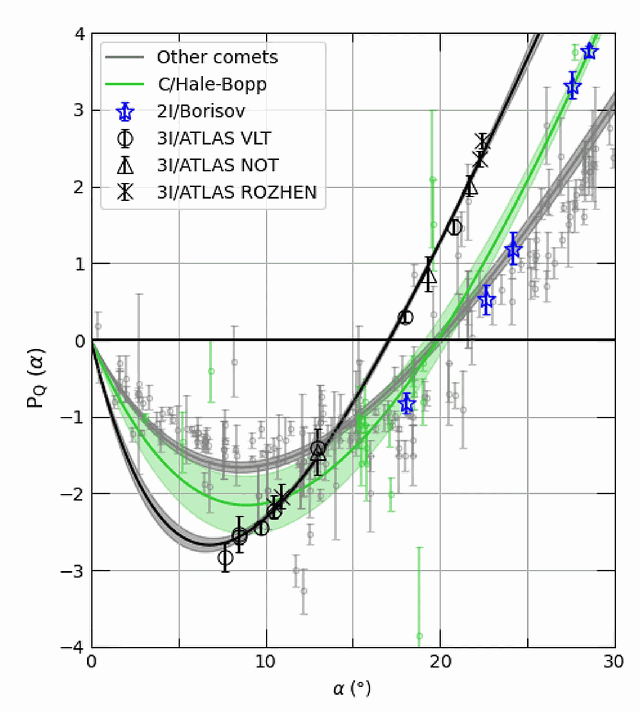On July 1, 2025, astronomers detected a mysterious object coming from the depths of interstellar space. It was identified by the Asteroid Terrestrial-impact Last Alert System (ATLAS) in Chile and officially designated 3I/ATLAS, becoming the third interstellar object ever recorded in our Solar System. Before it, only two other visitors had been confirmed: 1I/’Oumuamua, discovered in 2017, and 2I/Borisov, detected in 2019.
3I/ATLAS stood out from the very beginning due to its highly unusual trajectory and characteristics that challenged the traditional classifications of asteroids and comets. Its orbit revealed that it was not gravitationally bound to the Sun and had come from another star, passing rapidly through our Solar System before heading back into deep space. Initially, it was believed to be an interstellar comet due to its visible activity and coma formation, but more detailed observations quickly showed that something did not fit into conventional models.
Since its discovery, scientists around the world have turned their telescopes toward this enigmatic visitor. Early analyses indicated that it has a rare chemical composition and displays optical and physical phenomena never before seen in natural objects.
Until recently, all spectroscopic studies of 3I/ATLAS indicated that it had a reddish color. However, the most recent image, taken on September 7, 2025, by Michael Jäger and Gerald Rhemann, showed that the glow around the object had shifted to a greenish tone. This transition from red to bluish-green may be associated with a sharp increase in cyanide (CN) production, as reported by the Very Large Telescope on August 25, 2025. It was found that both cyanide and iron-free nickel production increase dramatically as the heliocentric distance decreases, following a power of approximately 9 (+/-1).

This sudden chemical and optical transformation added another layer of mystery to the object, occurring even before the discovery of its most surprising anomaly — its light signature.
A new study published on the preprint server arXiv revealed that 3I/ATLAS exhibits unprecedented optical behavior, never before observed in any natural object, whether from within or beyond our Solar System. The main anomaly detected relates to the polarization of the light reflected by the object — a property that can reveal crucial information about its shape, composition, and surface structure.
Polarization occurs when light, which is composed of oscillating electric and magnetic fields, interacts with asymmetric particles or surfaces. In the case of linear polarization, the fields oscillate in a single direction, while in circular polarization, they rotate continuously around their propagation axis. For objects like comets and asteroids, the polarization pattern provides clues about the composition and texture of the particles that make up their surface or coma.
In the case of 3I/ATLAS, the results are extremely unusual. The object exhibited a very deep negative polarization of -2.77%, observed at a phase angle of only 6.41°, with an extremely low inversion angle of 17.05°. In simple terms, this means that the light reflected by 3I/ATLAS behaves in a way that does not match any known patterns for comets.
“This combination is unique. Known comets are classified into high- or low-polarization categories, but 3I/ATLAS fits into neither. This polarimetric behavior has never been observed before, marking 3I/ATLAS as the first member of an entirely new class of objects for science,” said astrophysicist Avi Loeb.

This discovery makes 3I/ATLAS radically different from the two previously recorded interstellar objects:
- 1I/‘Oumuamua, which showed no signs of gas or dust but exhibited non-gravitational acceleration.
- 2I/Borisov, which behaved like a typical comet from our Solar System.
3I/ATLAS, on the other hand, presents a series of additional anomalies that make its origin even more mysterious:
- Intriguing trajectory: Its retrograde motion is aligned with the orbital plane of the Solar System’s planets to within just 5°, something that Loeb says has only a 1 in 500 chance of happening by coincidence.
- Colossal size: The nucleus is estimated to be up to 46 km in diameter. On October 3, 2025, the HiRISE camera aboard NASA’s Mars Reconnaissance Orbiter may capture high-resolution images, allowing its true size to be determined accurately.
- Never-before-seen anti-tail: When it was between 3 and 4.5 AU from the Sun, 3I/ATLAS exhibited a brightness that extended toward the Sun rather than away from it, something never observed in known comets.
- Anomalous chemical composition: The gas plume surrounding the object is composed of 87% CO₂, with small amounts of CO (9%) and H₂O (4%). In addition, iron-free nickel, typical of industrial alloys, and cyanide were detected, both increasing as the object approached the Sun.

These characteristics raise profound questions about the true nature of 3I/ATLAS. For some researchers, including Loeb, a technological origin cannot be ruled out at this stage, although more precise data is needed to confirm any bold hypothesis.
Attention now turns to October 2025, when HiRISE is expected to obtain the most detailed image ever taken of an interstellar object. This observation will be crucial to determining whether 3I/ATLAS is merely an extremely rare natural phenomenon or something that could challenge our current understanding of the cosmos.
“Science is exciting because it resembles a detective investigation. We need to keep an open mind until we have concrete evidence,” concluded Avi Loeb.










